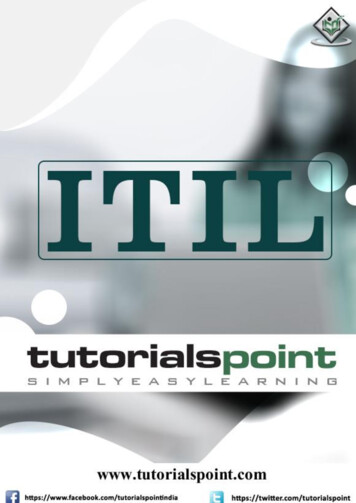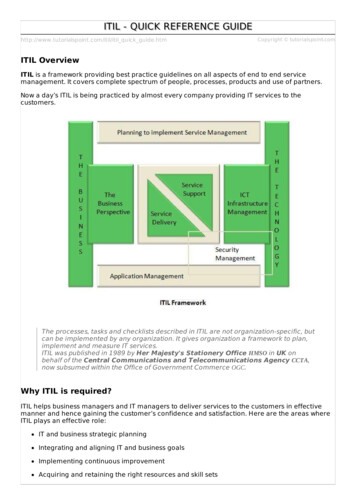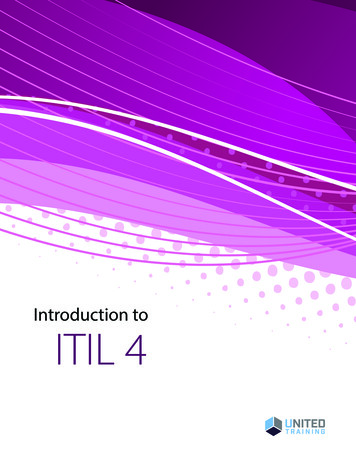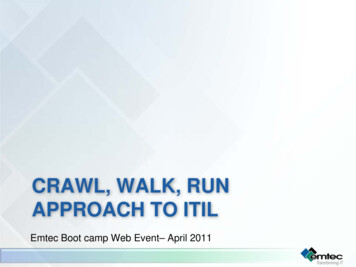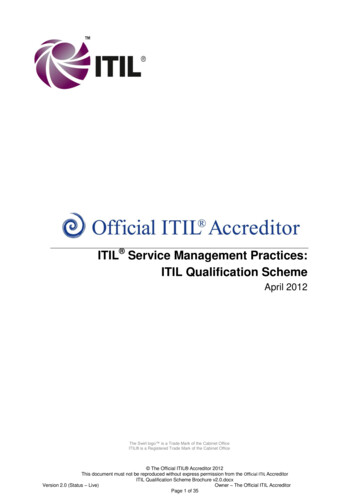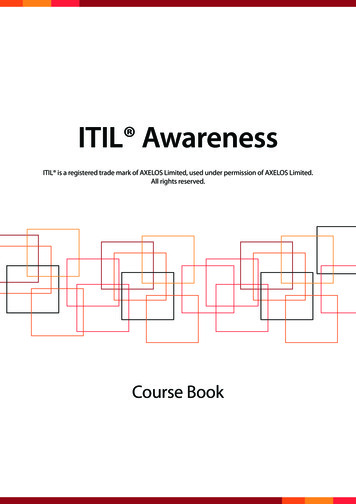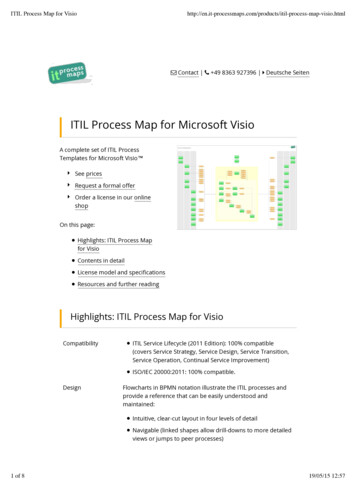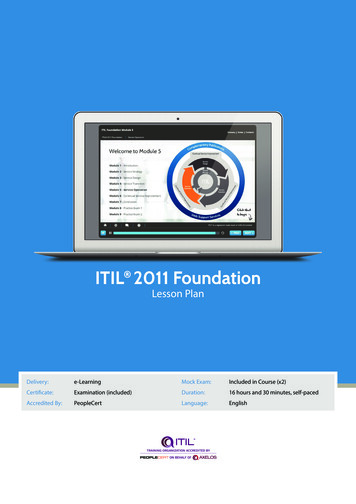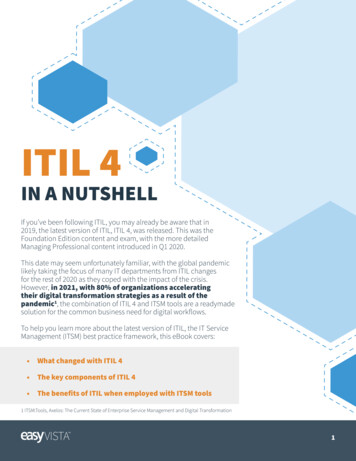
Transcription
ITIL 4IN A NUTSHELLIf you’ve been following ITIL, you may already be aware that in2019, the latest version of ITIL, ITIL 4, was released. This was theFoundation Edition content and exam, with the more detailedManaging Professional content introduced in Q1 2020.This date may seem unfortunately familiar, with the global pandemiclikely taking the focus of many IT departments from ITIL changesfor the rest of 2020 as they coped with the impact of the crisis.However, in 2021, with 80% of organizations acceleratingtheir digital transformation strategies as a result of thepandemic1, the combination of ITIL 4 and ITSM tools are a readymadesolution for the common business need for digital workflows.To help you learn more about the latest version of ITIL, the IT ServiceManagement (ITSM) best practice framework, this eBook covers: What changed with ITIL 4 The key components of ITIL 4 The benefits of ITIL when employed with ITSM tools1 ITSM.Tools, Axelos: The Current State of Enterprise Service Management and Digital Transformation1
What Changed with ITIL 4So much changed with ITIL 4, relative to ITIL v3/2011, but in this eBookwe will focus on purely the key changes. These include that: The focus of ITIL 4 has moved from IT Service Management toservice management as a whole to reflect the ability of organizationsto use ITSM capabilities and ITIL best practices outside of IT in enterpriseservice management or digital transformation scenarios. ITIL 4 is focused on value creation – or value co-creation – withthis reflected in the new Service Value System and Service ValueChain models. These replace the ITIL v3/2011 service lifecycle. The 26 ITIL v3/2011 processes and four functions have been supersededby ITIL 4’s 34 management practices – with this recognizing that therequired service management capabilities are more than simply processes. ITIL 4 includes the guiding principles that were introducedin 2016’s ITIL Practitioner Guide, albeit with an updateand a reduction from nine to seven principles. ITIL 4 has replaced the “4Ps” of ITIL v3/2011 with“The 4 Dimensions of Service Management.”There’s also a change in how the ITIL 4 content is delivered. Now, in addition to physical anddigital books, there’s a subscription-based download model for the 34 management practices ina PDF format. This is the only official way that this best practice guidance can be accessed.2
The Key Components of ITIL 4The best, and easiest, place to start when learning the key components of ITIL 4 is the Service ValueSystem model. This is presented in the diagram below – and shows what’s involved when demand forservices is turned into value.The Service Value System Service : AXELOS, “ITIL Foundation: Foundation Edition” (2019)Three of the five central elements of the Service Value System – the guiding principles, managementpractices, and the Service Value Chain – are covered in more detail across the next three sections.This leaves two elements: continual improvement and governance.1. Continual improvement replaces ITIL v3/2011’s continual service improvement(CSI), with two clear differences beyond the change in naming. First, it’s now a managementpractice rather than a separate book. Second, it applies to more than the improvementof services. For example, continual improvement could be used to improve processes,organizational structure, operational performance, partner working, and technology use.2. Three important aspects of governance are called out in ITIL 4:the evaluation of whether things are changing in line with stakeholder needs andexternal forces; direction, in terms of assigning responsibility for strategy development,policy creation, and execution; and the monitoring of organizational performance.3
Another important element of ITIL 4 that’s not shown in the Service Value System diagram is referred toas “The 4 Dimensions of Service Management”.These four dimensions replace the ITIL v3/2011 4Ps of people, process, product (technology), andpartners. As the diagram below shows, the four dimensions aren’t overly different from the 4Ps – withpeople, process, technology, and partners all evident. However, the inclusion of the factors that applyto all four dimensions of service management makes for a more beneficial, but more complicated, viewof the service management ecosystem of an organization.The Four Dimensions of Service ManagementPoliticalFactors1Organizations &People2Information &TechnologyEconomicalFactorsProducts alFactorsPartners &SuppliesValue Streams &Processes34TechnologicalFactorsSource: AXELOS, “ITIL Foundation: Foundation Edition” (2019)4
ITIL’s Guiding PrinciplesThe seven ITIL guiding principles are shown in the table below:ITIL Guiding PrincipleWhat It MeansFocus on value“Everything that the organization does needs to map, directly or indirectly,to value for the stakeholders. The focus on value principle encompassesmany perspectives, including the experience of customers and users.”Start where you are“Do not start from scratch and build something new without considering what is alreadyavailable to be leveraged. There is likely to be a great deal in the current services, processes,programs, projects, and people that can be used to create the desired outcome. The currentstate should be investigated and observed directly to make sure it is fully understood.”Progress iterativelywith feedback“Do not attempt to do everything at once. Even huge initiatives must be accomplishediteratively. By organizing work into smaller, manageable sections that can beexecuted and completed in a timely manner, it is easier to maintain a sharper focuson each effort. Using feedback before, throughout, and after each iteration willensure that actions are focused and appropriate, even if circumstances change.”Collaborate andpromote visibility“Working together across boundaries produces results that have greater buy-in, morerelevance to objectives, and increased likelihood of long-term success. Achieving objectivesrequires information, understanding, and trust. Work and consequences should be madevisible, hidden agendas avoided, and information shared to the greatest degree possible.”Think and workholistically“No service, or element used to provide a service, stands alone. The outcomes achievedby the service provider and service consumer will suffer unless the organization workson the service as a whole, not just on its parts. Results are delivered to internal andexternal customers through the effective and efficient management and dynamicintegration of information, technology, organization, people, practices, partners,and agreements, which should all be coordinated to provide a defined value.”Keep it simpleand practical“If a process, service, action or metric fails to provide value or produce a usefuloutcome, eliminate it. In a process or procedure, use the minimum number ofsteps necessary to accomplish the objective(s). Always use outcome-based thinkingto produce practical solutions that deliver results.”Optimize and automate“Resources of all types, particularly human resources, should be used to their best effect.Eliminate anything that is truly wasteful and use technology to achieve whatever it iscapable of. Human intervention should only happen where it really contributes value.”Source: AXELOS, “ITIL Foundation: Foundation Edition” (2019)5
ITIL 4’s Management PracticesITIL 4’s 34 management practices are split across three differentiating groupings as follows:1. General management practices 142. Service management practices 173. Technical management practices 3Where a management practice is defined byITIL 4 as: “ a set of organizational resourcesdesigned for performing work or accomplishingan objective.” Importantly, a practice is morethan just the process(es).The 34 ITIL Management PracticesGeneral ManagementService ManagementTechnical ManagementArchitecture managementAvailability managementDeployment managementContinual improvementBusiness analysisInfrastructure and platform managementInformation security managementCapacity and performance managementSoftware development and managementKnowledge managementChange enablementMeasurement and reportingIncident managementOrganizational change managementIT asset managementPortfolio managementMonitoring and event managementProject managementProblem managementRelationship managementRelease managementRisk managementService catalog managementService financial managementService configuration managementStrategy managementService continuity managementSupplier managementService designWorkforce and talent managementService deskService level managementService request managementService validation and testing6
The three different types of practice have been created as follows1:1. General management practices – “have been adopted and adapted forservice management from general business management domains.”2. Service management practices – “have been developedin service management and ITSM industries.”3. Technical management practices – “have been adapted from technologymanagement domains for service management purposes by expandingor shifting their focus from technology solutions to IT services.”If you’re familiar with ITIL v3/2011, then you’ll recognize many of these practices and it hence might beeasy to overlook the changes. For example, name changes such as “capacity management” changing to“capacity and performance management”, “change management” to “change enablement”, and “eventmanagement” to “monitoring and event management.”The practices themselves have changed too, even where the name has stayed the same. This goesbeyond the addition of non-process-related information, to recognize that the real-world use of thesecapabilities has moved on since 2011. For example: Business relationship management has been replaced bythe all-encompassing relationship management. Change enablement reflects the advancement ofDevOps adoption and the need for agility. Incident management includes the concept of “swarming.” Information security management is revised contentbased on the AXELOS RESILIA publication. Problem management reintroduces error control and problem control from ITIL v2 . Release management is separated from deployment management. Service level management includes guidance on third-party serviceproviders such as outsourcers and cloud service providers.There are also new areas of ITIL 4 coverage to note. For example, the IT asset management,organizational change management, service desk, software development and management, andworkforce and talent management practices.1 AXELOS, “ITIL Foundation: Foundation Edition” (2019)7
The ITIL 4 Service Value ChainAs shown in the earlier diagram, the Service Value Chain sits at the heart of the service value system.The ITIL 4 guidance describes it as “an operating model which outlines the key activities required torespond to demand and facilitate value realization through the creation and management of productsand services.” It’s comprised of six repeatable elements as shown below.The Service Value Chain ModelPlanDesign &TransitionDemandEngageObtain/BuildProducts &ServicesDeliver &SupportValueImproveSource: AXELOS, “ITIL Foundation: Foundation Edition” (2019)Looking at the above diagram from the outside-in, the six elements– or activities – within the Service Value Chain are:1. Plan – the gaining of a shared understanding of what’s needed for service provision and support.2. Improve – the continual improvement of products, services, and practices.3. Engage – ensuring that stakeholder needs are fully understoodand that good working relationships are created.4. Design and Transition – ensuring that the delivered products and servicesmeet stakeholder expectations across quality, cost, and time-to-market.5. Obtain/Build – ensuring that the service components areavailable as needed (whether created or bought in).6. Deliver and Support – ensuring that service delivery and supportmeet the agreed specifications and expectations.The Service Value Chain allows for the formation of various “value streams” that define how value iscreated for stakeholders. Importantly, the activities within the Service Value Chain can be reused withina single value stream. For example, a value steam might “double back” through a previous activity toreflect multiple instances of engagement.8
The Benefits of ITIL and ITSM ToolsThe benefits of ITIL can be viewed from a number of perspectives. For example, whether it’s the use ofITSM per se, the use of ITIL guidance, or the use of an ITSM tool that really makes the difference – withbenefits often overlapping these three areas to some extent.ITSM BenefitsThe use of ITSM, even without the adoption of ITIL best practice guidance, is highly beneficial toorganizations. For example, that ITSM: Takes the focus from individual IT domains to servicesand their delivery and improvement Improves IT delivery and support through formal practices Increases speed and efficiency of operations Reduces costs through standardization Defines responsibilities and accountabilities Measures success closer to the point of service consumption Allows for the comparison of operations and performance between organizations Use can be extended to other business functions toimprove their operations and outcomesUltimately, this begins an improvement journey to bring about “better, faster,and cheaper” service delivery and support operations and outcomes.9
ITIL BenefitsThe introduction of ITIL service management best practice guidance then adds an extra layer ofbenefits, often amplifying the benefits of ITSM use. In addition to the benefits of ITSM, the introductionof ITIL brings: Standardization and optimization based on proven best practice. Increased control and governance. A better platform for demonstrating IT’s, or any business function’s, value. A common language for both internal and external conversationson operations, performance, and improvement. The integration of newer practices such as Agile, DevOps, and Lean plus the use of newertechnologies (based on the optimize and automate guiding principle in particular).ITSM Tool BenefitsMost modern ITSM tools have been designed with ITIL best practices in mind. Plus, using automationand other technology-based enablement to improve operations and outcomes for both IT departmentsand other business functions – via enterprise service management or digital transformation strategies.ITSM tools again add an extra later of benefits, amplifying the benefits of both ITSM and ITIL practicesthrough automation and other capabilities. For example: The benefits of automation, and new technologies, make for “better, faster, andcheaper” operations and outcomes; in particular, meeting the increasing customer andemployee demands and expectations of IT and other corporate service providers. Omnichannel service and support capabilities offer choice to employees and potentially customers. Knowledge is more easily captured and shared to improve operations and outcomes. There’s greater insight into operational performance in terms of reporting and analytics. There’s a greater ability for rapid improvement and innovation.Ultimately, it’s the ITSM tool that truly delivers the full benefits of ITSM and ITIL andprovides the platform for the digital transformation that organizations need in 2021 andbeyond – not only in the IT department but across the whole enterprise.10
Next StepsWhile much of ITIL 4 is familiar at a practice-level, it’s now a completely different approach to servicemanagement that elevates those who use it from being focused on ITSM processes to value creation (orco-creation).If you would like to understand more about ITIL 4 and how it can help your organization, in both IToperations and digital transformation terms, then get in touch with one of our EasyVista experts today!Learn how you can streamline ITIL adoptionwith the EasyVista platform.GET A DEMO11
ITIL 4's Management Practices The 34 ITIL Management Practices ITIL 4's 34 management practices are split across three differentiating groupings as follows: Where a management practice is defined by ITIL 4 as: " a set of organizational resources designed for performing work or accomplishing an objective." Importantly, a practice is more


